Effects of Two Pilot Injection on Combustion and Emissions in a PCCI Diesel Engine
Abstract
1. Introduction
2. Methodology
2.1. Experimental Facility
2.2. Modeling
2.3. Operating Methodology and Model Validation
3. Results
3.1. Effects of Pilot Injection Timing
3.1.1. Characteristic of Heat Release
3.1.2. Combustion Features at Particular Moments
3.1.3. Emission Characteristics
3.2. Effect of Two Pilot Injection Proportions
3.2.1. Characteristic of Heat Release
3.2.2. Combustion Features at Particular Moments
3.2.3. Emission Characteristics
4. Discussion
5. Conclusions
Author Contributions
Funding
Institutional Review Board Statement
Informed Consent Statement
Data Availability Statement
Conflicts of Interest
Appendix A
| QM | Main injection quantity |
| TDC | Top dead center |
| BDC | Bottom dead center |
| CA10 | When the accumulated HRR attained ten percent of the total HRR |
| CA50 | When the accumulated HRR attained fifty percent of the total HRR |
| CA90 | When the accumulated HRR attained ninety percent of the total HRR |
| HRR | Heat release rate |
References
- Landau, D.; Novack, L.; Yitshaksade, M. Nitrogen dioxide pollution and hazardous household environment: What impacts more congenital malformations. Chemosphere 2015, 139, 340–348. [Google Scholar] [CrossRef] [PubMed]
- Pedersen, M.; Andersen, Z.J.; Stafoggia, M. Ambient air pollution and primary liver cancer incidence in four European cohorts within the ESCAPE project. Environ. Res. 2017, 154, 226–233. [Google Scholar] [CrossRef] [PubMed]
- Fraioli, V.; Beatrice, C.; Blasio, G.D.; Belgiorno, G.; Migliaccio, M. Multidimensional Simulations of Combustion in Methane-Diesel Dual-Fuel Light-Duty Engines. In Proceedings of the SAE World Congress Experience (WCX 17), Detroit, MI, USA, 4–6 April 2017. [Google Scholar] [CrossRef]
- Mueller, C.J.; Nilsen, C.W.; Ruth, D.J.; Gehmlich, R.K.; Pickett, L.M.; Skeen, S.A. Ducted fuel injection: A new approach for lowering soot emissions from direct-injection engines. Appl. Energy 2017, 204, 206–220. [Google Scholar] [CrossRef]
- Singh, A.P.; Agarwal, A.K. Combustion characteristics of diesel HCCI engine: An experimental investigation using external mixture formation technique. Appl. Energy 2012, 99, 116–125. [Google Scholar] [CrossRef]
- Singh, G.; Singh, A.P.; Agarwal, A.K. Experimental investigations of combustion, performance and emission characterization of biodiesel fueled HCCI engine using external mixture formation technique. Sustain. Energy Technol. Assess. 2014, 6, 116–128. [Google Scholar]
- Sharma, T.K.; Rao GA, P.; Murthy, K.M. Homogeneous Charge Compression Ignition (HCCI) Engines: A Review. Arch. Comput. Methods Eng. 2015, 23, 1–35. [Google Scholar] [CrossRef]
- Kiplimo, R.; Tomita, E.; Kawahara, N.; Yokobe, S. Effects of spray impingement, injection parameters, and EGR on the combustion and emission characteristics of a PCCI diesel engine. Appl. Therm. Eng. 2012, 37, 165–175. [Google Scholar] [CrossRef]
- Torregrosa, A.J.; Broatch, A.; García, A.; Mónico, L.F. Sensitivity of combustion noise and NOx and soot emissions to pilot injection in PCCI Diesel engines. Appl. Energy 2013, 104, 149–157. [Google Scholar] [CrossRef]
- Jain, A.; Singh, A.P.; Agarwal, A.K. Effect of split fuel injection and EGR on NOx and PM emission reduction in a low temperature combustion (LTC) mode diesel engine. Energy 2017, 122, 249–264. [Google Scholar] [CrossRef]
- Lu, Y.; Yu, W.; Su, W. Using Multiple Injection Strategies in Diesel PCCI Combustion: Potential to extend Engine Load, Improve Trade-Off of Emissions and Efficiency; SAE Technical Papers 2011-0148-7191; SAE International: Warrendale, PA, USA, 2011; ISSN 0148-7191. [Google Scholar]
- Yu, H.; Liang, X.; Shu, G.; Wang, Y.; Sun, X.; Zhang, H. Numerical investigation of the effect of two-stage injection strategy on combustion and emission characteristics of a diesel engine. Appl. Energy 2018, 227, 634–642. [Google Scholar] [CrossRef]
- Park, Y.; Bae, C. Effects of Single and Double Post Injections on Diesel PCCI Combustion; SAE Technical Papers 2013-01-0010; SAE International: Warrendale, PA, USA, 2013; ISSN 0148-7191. [Google Scholar]
- Cao, J.; Leng, X.; He, Z.; Wang, Q.; Shang, W.; Li, B. Experimental study of the diesel spray combustion and soot characteristics for different double-injection strategies in a constant volume combustion chamber. J. Energy Inst. 2019, 93, 335–350. [Google Scholar] [CrossRef]
- Yin, B.; Wang, J.; Yang, K.; Jia, H. Optimization of EGR and split injection strategy for light vehicle diesel low temperature combustion. Int. J. Automot. Technol. 2014, 15, 1043–1051. [Google Scholar] [CrossRef]
- Xuan, T.; He, Z.; Jiang, Z.; Yan, Y. Study on effect of fuel injection strategy on combustion noise and exhaust emission of diesel engine. Therm. Sci. 2013, 17, 81–90. [Google Scholar]
- Fajri, H.R.; Jafari, M.J.; Shamekhi, A.H.; Jazayeri, S.A. A numerical investigation of the effects of combustion parameters on the performance of a compression ignition engine toward NOx emission reduction. J. Clean. Prod. 2017, 167, 140–153. [Google Scholar] [CrossRef]
- Choi, H.; Lee, J.; Hong, K.; Lee, S.; Choi, S.; Yu, S.; Min, K. Comparison of the effects of multiple injection strategy on the emissions between moderate and heavy EGR rate conditions: Part 2—Post injections. J. Mech. Sci. Technol. 2013, 27, 2217–2223. [Google Scholar] [CrossRef]
- Park, S.; Lee, K.S.; Park, J. Parametric study on EGR cooler fouling mechanism using model gas and light-duty diesel engine exhaust gas. Energies 2018, 11, 3161. [Google Scholar] [CrossRef]
- D’Ambrosio, S.; Ferrari, A. Potential of multiple injection strategies implementing the after shot and optimized with the design of experiments procedure to improve diesel engine emissions and performance. Appl. Energy 2015, 155, 933–946. [Google Scholar] [CrossRef]
- Dimitrakopoulos, N.; Belgiorno, G.; Tunér, M.; Tunestål, P.; Di Blasio, G. Effect of EGR routing on efficiency and emissions of a PPC engine. Appl. Therm. Eng. 2019, 152, 742–750. [Google Scholar] [CrossRef]
- Herfatmanesh, M.R.; Lu, P.; Attar, M.A.; Zhao, H. Experimental investigation into the effects of two-stage injection on fuel injection quantity, combustion and emissions in a high-speed optical common rail diesel engine. Fuel 2013, 109, 137–147. [Google Scholar] [CrossRef]
- Yang, K.; Nishida, K.; Yamakawa, H. Effect of split injection ratio on combustion process of diesel spray into two-dimensional piston cavity. Fuel 2020, 260, 116316. [Google Scholar] [CrossRef]
- Ishiyama, T.; Kang, J.; Ozawa, Y. Improvement of performance and reduction of exhaust emissions by pilot-fuel-injection control in a lean-burning natural-gas dual-fuel engine. SAE Int. J. Fuels Lubr. 2012, 5, 243–253. [Google Scholar] [CrossRef]
- Elzahaby, A.M.; Elkelawy, M.; Bastawissi, H.A.; El_Malla, S.M.; Naceb, A.M.M. Kinetic modeling and experimental study on the combustion, performance and emission characteristics of a PCCI engine fueled with ethanol-diesel blends. Egypt. J. Pet. 2018, 27, 927–937. [Google Scholar] [CrossRef]
- Dawson, M.; Borman, D.; Hammond, R.B.; Lesnic, D.; Rhodes, D. Moving boundary models for the growth of crystalline deposits from undetected leakages of industrial process liquors. Comput. Chem. Eng. 2014, 71, 331–346. [Google Scholar] [CrossRef][Green Version]
- Kavtaradze, R.Z.; Sergeev, S.S. New alternative (partially homogeneous) combustion process as a method for reduction of concentrations of nitric oxides and soot in combustion products of diesel. High Temp. 2014, 52, 282–296. [Google Scholar] [CrossRef]
- Gafoor, C.P.A.; Gupta, R. Numerical investigation of piston bowl geometry and swirl ratio on emission from diesel engines. Energy Convers. Manag. 2015, 101, 541–551. [Google Scholar] [CrossRef]
- Jafarmadar, S.; Khalilarya, S.; Shafee, S.; Barzegar, R. Modeling the effect of spray/wall impingement on combustion process and emission of DI diesel engine. Therm. Sci. 2009, 13, 23–33. [Google Scholar] [CrossRef]
- Renganathan, M.; Raj, R.T.K. Numerical investigations of spray droplet parameters in a direct injection diesel engine using 3-Z extended coherent flame model. ICEETS 2013, 768, 226–230. [Google Scholar] [CrossRef]
- Trisjono, P.; Pitsch, H. A direct numerical simulation study on NO formation in lean premixed flames. Proc. Combust. Inst. 2017, 36, 2033–2043. [Google Scholar] [CrossRef]
- Mei, D.; Hielscher, K.; Baar, R. Study on combustion process and emissions of a single-cylinder diesel engine fueled with DMC/diesel blend. J. Energy Chem. 2014, 140, 04013004. [Google Scholar] [CrossRef]

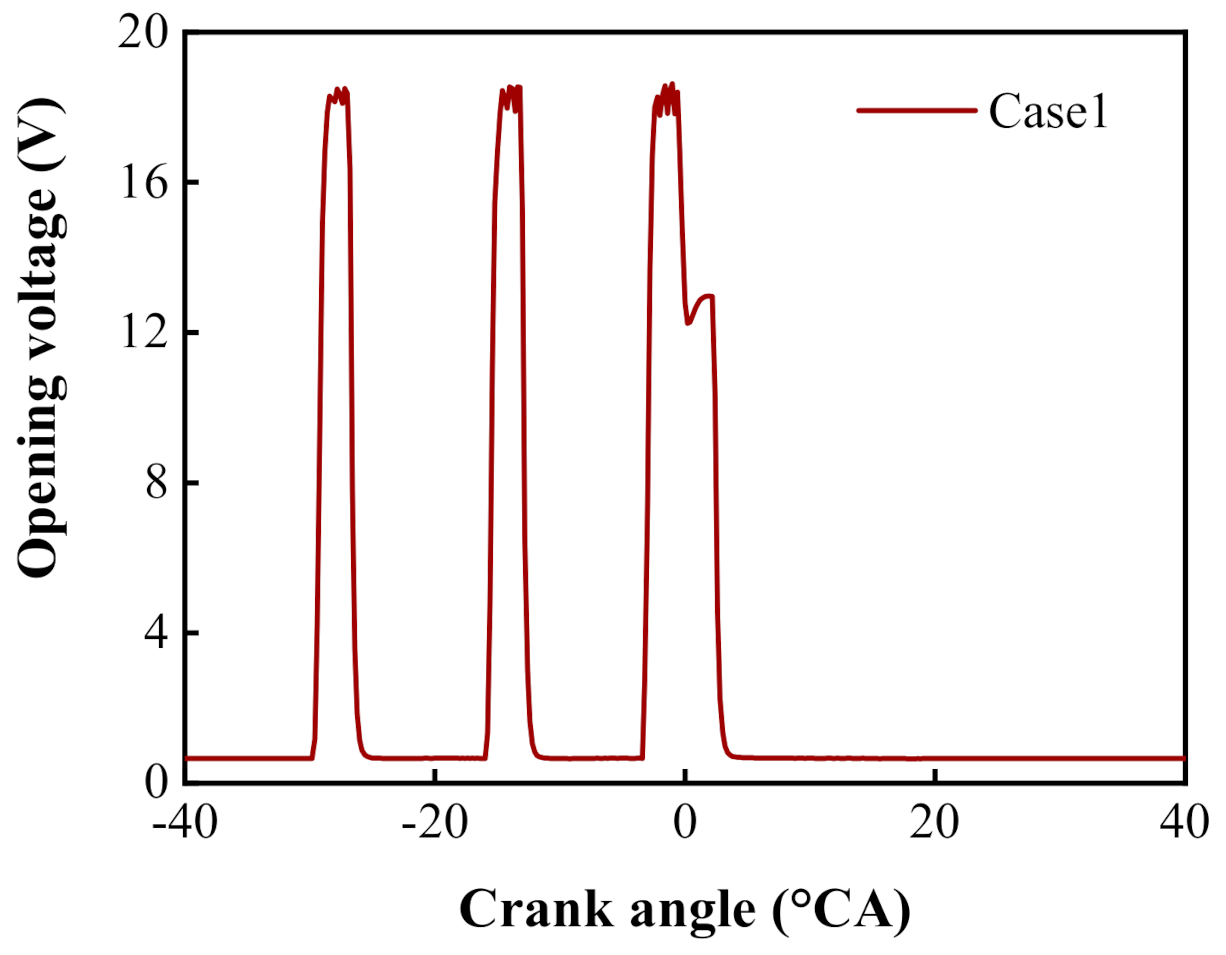
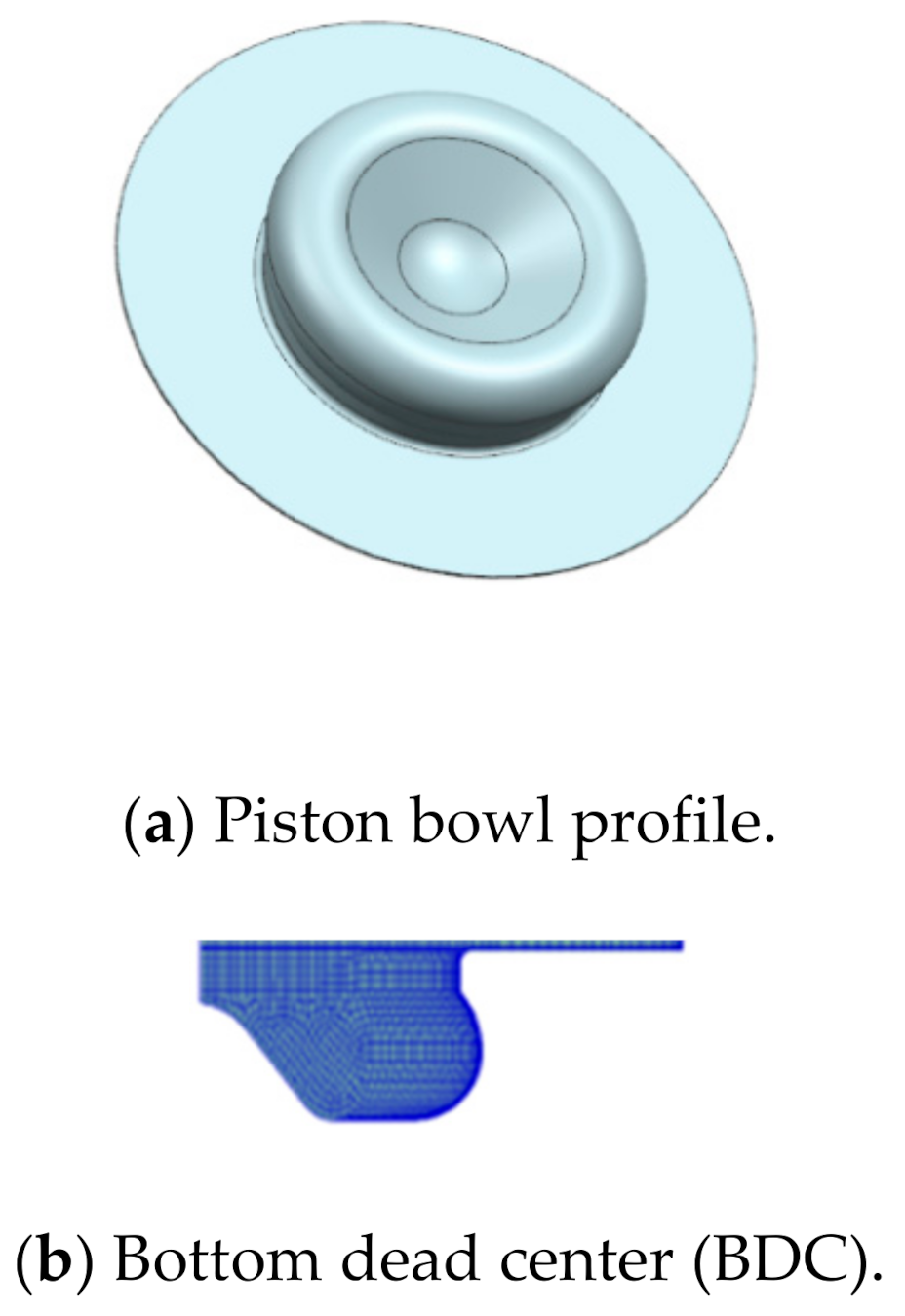


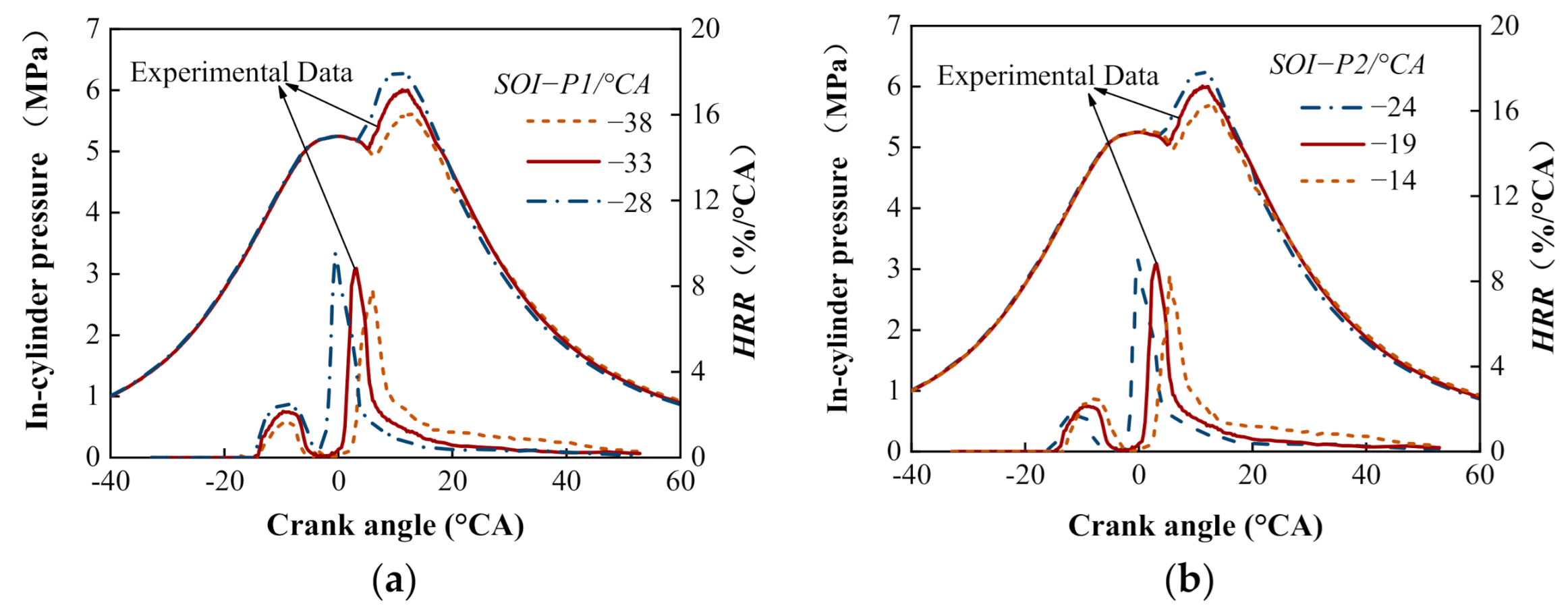

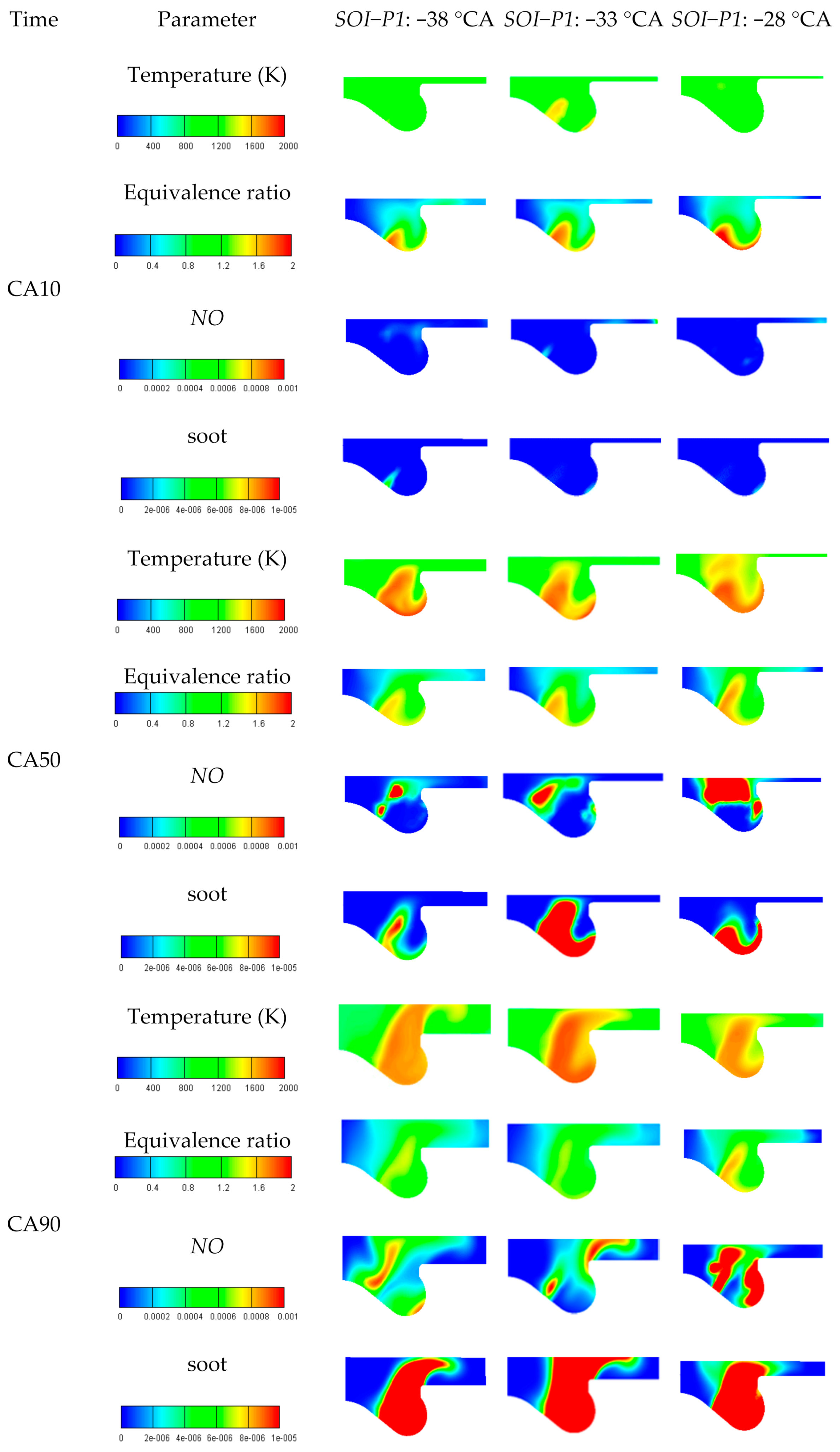
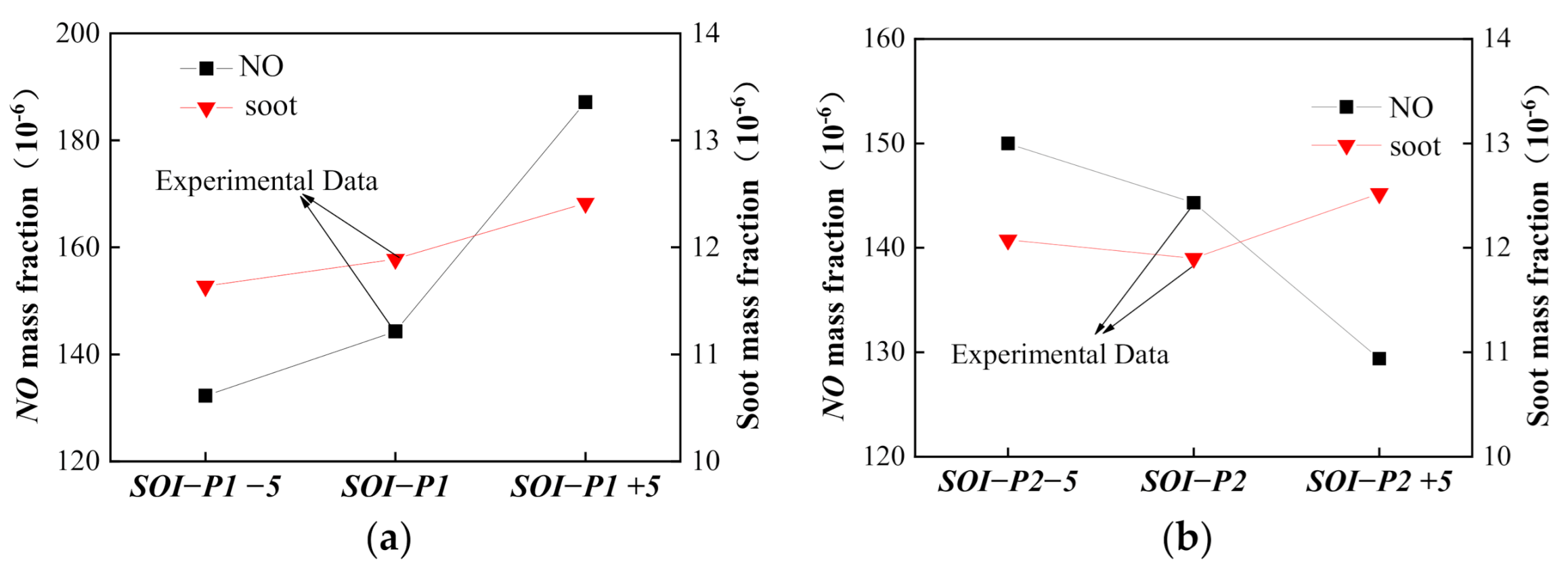
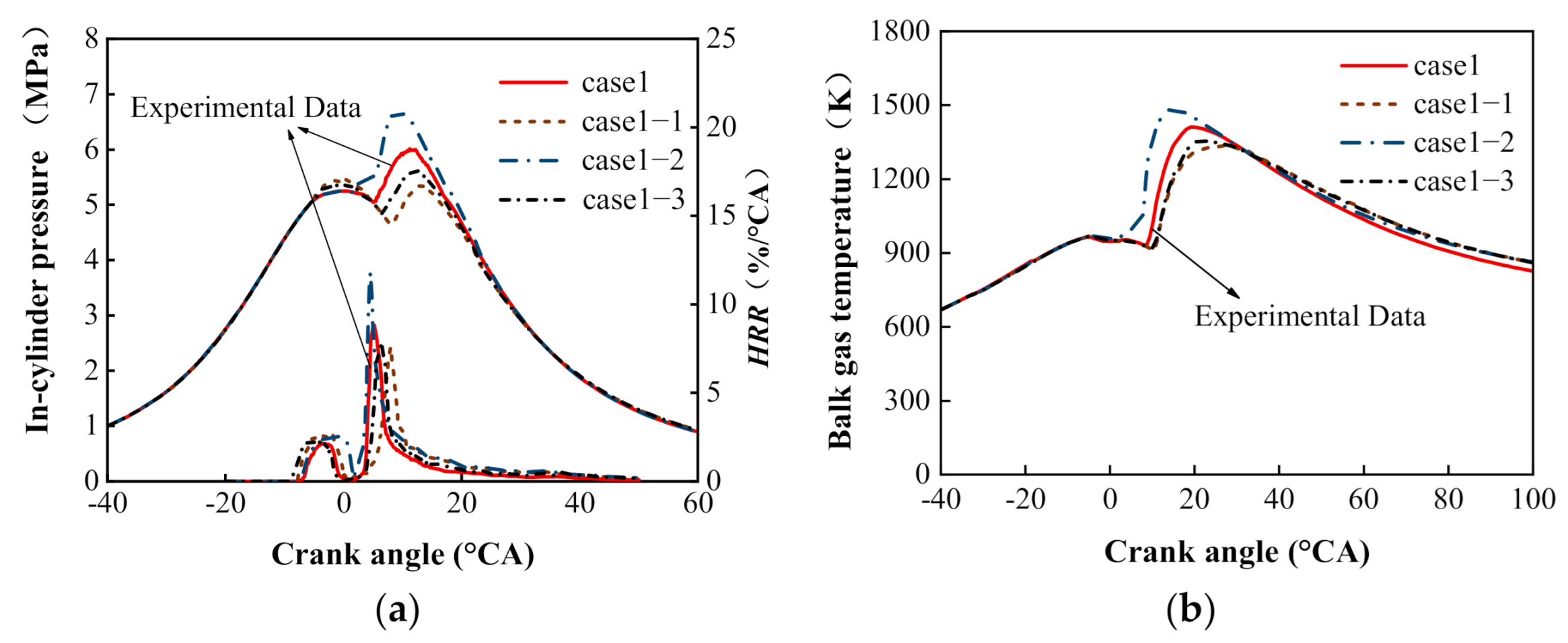
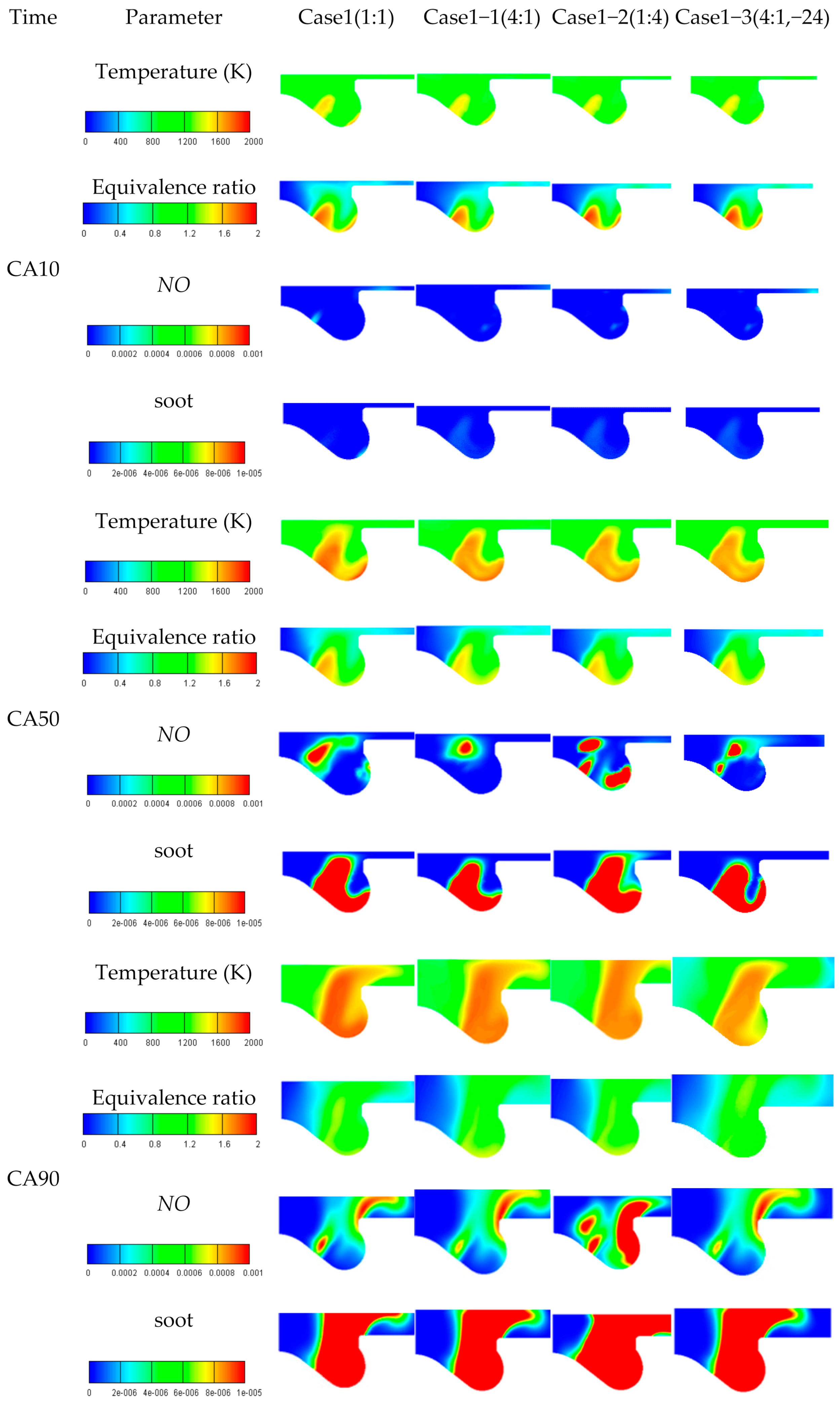
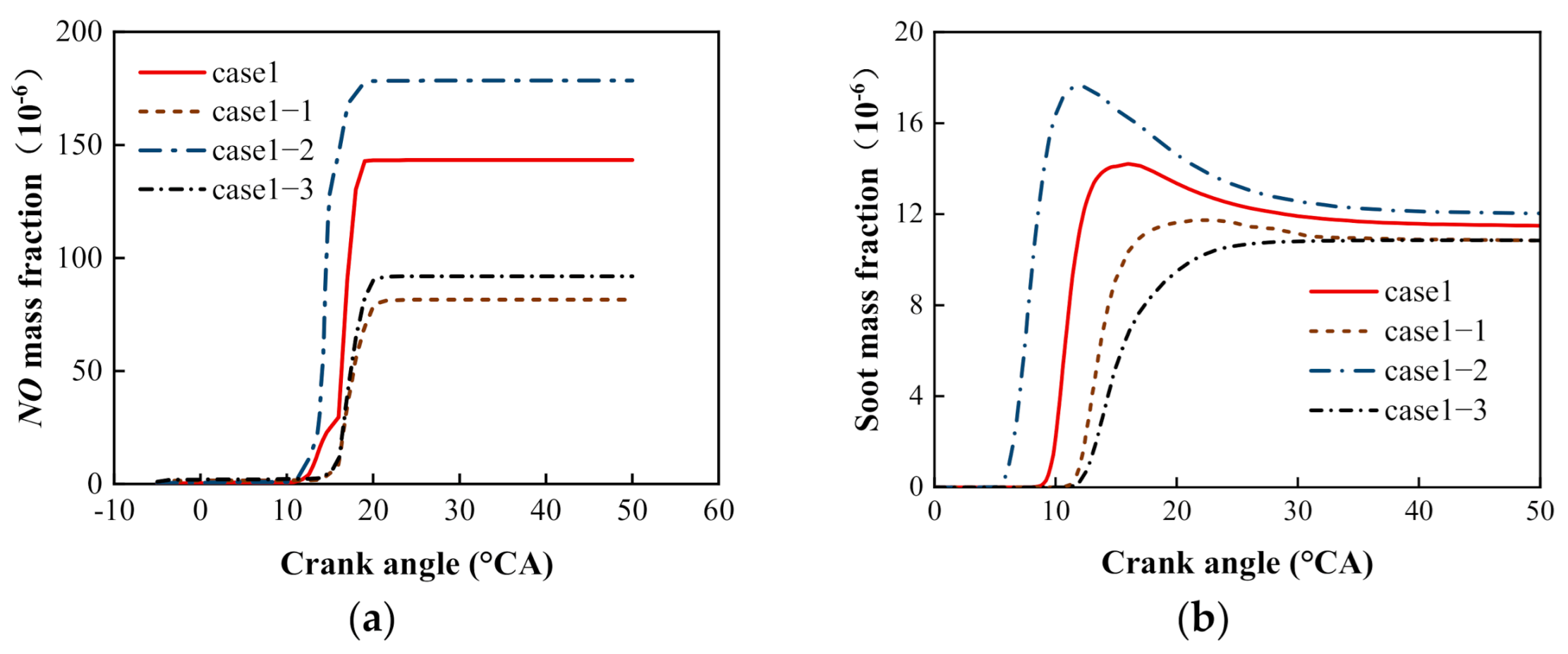
| Make and Model | Direct Injection |
|---|---|
| Number of nozzle orifices | 7 |
| Spray angle (°) | 153 |
| Injector | Bosch CRI-2.2 |
| Rated speed (rpm) | 4000 |
| Compression ratio | 15.88 |
| Displacement (L) | 0.537 |
| Piston stroke (mm) | 88.34 |
| Cylinder bore (mm) | 88 |
| Instrumentation | Manufacturer | Type |
|---|---|---|
| Fuel mass flow meter | Siemens AG | 1GG6164 |
| Air mass flow meter | ABB | Sensyflow |
| Piezoelectric sensor | Kistler | 6043ASP |
| Combustion analyzer | AVL List GmbH | IndiCom |
| Gas analyzer | HORIBA | 7170DEGR |
| Opacimeter | AVL | 415 SE |
| Models | Definition |
|---|---|
| Turbulence | k−zeta−f |
| Atomization/breakup mode | Dukowicz/WAVE |
| Combustion | ECFM−3Z |
| Spray impingement | Walljet1 |
| Nitrogen oxide (NOx) formation | Extended Zeldovich |
| Soot formation | Kinetic |
| Item | Value |
|---|---|
| Piston top temperature (K) | 596 |
| Cylinder head temperature (K) | 557 |
| Cylinder wall temperature (K) | 407 |
| Initial fuel temperature (K) | 320 |
| Exhaust gas recirculation (EGR) (%) | 44 |
| Initial temperature (K) | 367 |
| Initial pressure (MPa) | 0.135 |
| Injection Scheme | SOI−P1 (°CA) | SOI−P2 (°CA) | SOI−M (°CA) | QM (mg) | Q1 (mg) | Q2 (mg) |
|---|---|---|---|---|---|---|
| Case1 | −33 | −19 | −6 | 8.26 | 1.84 | 1.84 |
| Case2 | −38/−33/−28 | −19 | −6 | 8.26 | 1.84 | 1.84 |
| Case3 | −33 | −24/−19/−14 | −6 | 8.26 | 1.84 | 1.84 |
| Case1-1 | −33 | −19 | −6 | 8.26 | 2.94 | 0.74 |
| Case1-2 | −33 | −19 | −6 | 8.26 | 0.74 | 2.94 |
| Case1-3 | −33 | −24 | −6 | 8.26 | 2.94 | 0.74 |
| Injection Scheme | SOI−P1 (°CA) | SOI−P2 (°CA) | SOI−M (°CA) | QM (mg) | Q1 (mg) | Q2 (mg) |
|---|---|---|---|---|---|---|
| Pmi = 0.44 MPa | −30 | −16 | −3 | 8.31 | 1.84 | 1.84 |
| −33 | −19 | −6 | 8.26 | 1.84 | 1.84 | |
| −36 | −22 | −9 | 8.12 | 1.84 | 1.84 |
Publisher’s Note: MDPI stays neutral with regard to jurisdictional claims in published maps and institutional affiliations. |
© 2021 by the authors. Licensee MDPI, Basel, Switzerland. This article is an open access article distributed under the terms and conditions of the Creative Commons Attribution (CC BY) license (http://creativecommons.org/licenses/by/4.0/).
Share and Cite
Mei, D.; Yu, Q.; Zhang, Z.; Yue, S.; Tu, L. Effects of Two Pilot Injection on Combustion and Emissions in a PCCI Diesel Engine. Energies 2021, 14, 1651. https://doi.org/10.3390/en14061651
Mei D, Yu Q, Zhang Z, Yue S, Tu L. Effects of Two Pilot Injection on Combustion and Emissions in a PCCI Diesel Engine. Energies. 2021; 14(6):1651. https://doi.org/10.3390/en14061651
Chicago/Turabian StyleMei, Deqing, Qisong Yu, Zhengjun Zhang, Shan Yue, and Lizhi Tu. 2021. "Effects of Two Pilot Injection on Combustion and Emissions in a PCCI Diesel Engine" Energies 14, no. 6: 1651. https://doi.org/10.3390/en14061651
APA StyleMei, D., Yu, Q., Zhang, Z., Yue, S., & Tu, L. (2021). Effects of Two Pilot Injection on Combustion and Emissions in a PCCI Diesel Engine. Energies, 14(6), 1651. https://doi.org/10.3390/en14061651






